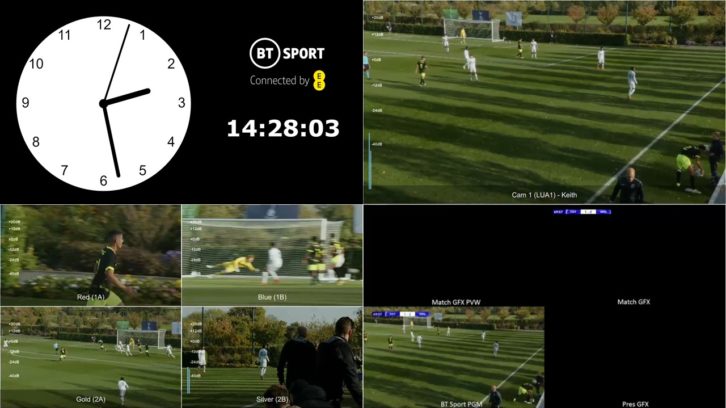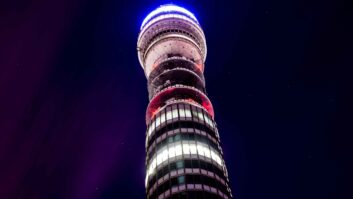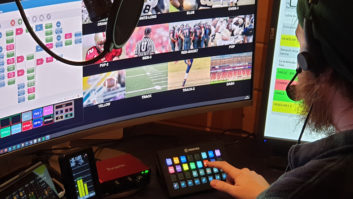BT Sport has this week completed a proof-of-concept trial of producing a UEFA Youth League match fully in the cloud.
On Wednesday, the broadcaster aired the game between Tottenham Hotspur and Sporting CP at the Hotspur Way Training Ground in Enfield.
The game was the first UEFA club match produced in the cloud – showcasing the future roadmap for live football production options, as well as the possibility of significantly reducing sustainability footprints in comparison to a traditional outside broadcast workflow.
Traditionally, a UEFA Youth League match employs six cameras, an OB truck, and another vehicle containing cameras, tripods, microphones, cables etc, with about 25 people on site.
But for the proof-of-concept, BT Sport used cellular bonding packs from LiveU to transmit signals into the cloud environment via a mix of 5G and fixed broadband.
“We picked it up in the public cloud, in our AWS instance, decoded that into our production environment, and within that environment, we ran all the production tools you’d expect it to find in the truck,” BT Sport’s chief engineer Andy Beale explains.
The broadcaster employed two AWS instances, in Dublin and London, which were exactly the same. “We brought all the feeds into both, because you can do that now, it’s totally opex-based, so we could spin up that little bit of extra resilience for the time we needed it,” adds Beale.

“The only time it came back to ground was at the end when we sent back to the MCR our BT Sport programme feed, BT Sport clean feed and the world feed for the UEFA world feed partners,” adds Beale.
This meant the team at Stratford was also reduced, with seven working in the gallery, compared to the traditional setup of five in the OB track and four in Stratford.
“They could actually be anywhere,” add Beale, “we could have put those control surfaces anywhere in the world. We did it at Stratford because we’ve got really good internet and we’ve got space for the team to work together, and having worked on that game which kicked off at one o’clock, they could work on an evening match. So, it’s efficient in terms of people travelling to work.”

BT Sport’s chief operating office Jamie Hindhaugh is quick to stress the broadcaster is not looking to reduce the number of staff working on its sports coverage by moving to a cloud-based workflow. “The ambition is to look at greener, more flexible ways of doing things because the end result has to be right for our customers,” he adds.
Instead, says Hindhaugh, this type of working frees-up resource for the broadcaster to do more. “It’s about looking at further opportunities around programming and content creation, all delivered in a greener, cleaner way, but adding that element and opportunity around creativity and enhancing the product, which has to be our ultimate goal for BT Sport. We want to keep getting better. We want to keep taking people closer to the action and this sort of technology is just a great way of giving us more accessibility to do things in a way that enhances our product.
“The key thing is that we’ve all got to learn what cloud really means, what these cloud tools can really do,” continues Hindhaugh. “I always think it’s good to understand what the realities of cloud means from a production and content experience for our customers.”
UEFA trusted BT Sport with the trial because of their previous work of pushing the boundaries in terms of what technology can do. “If you look at our relationship with UEFA since 2015, we’ve been the first to 4K, HDR, Dolby Atmos, 8K and all of this is because we’ve got such a strong relationship with our partners and especially UEFA,” Hindhaugh explains.
“This also forms part of UEFA’s work on its sustainability strategy for 2030, and it’s also aligned with our adage, the heart of sport. We’re still looking at creative ways of enhancing content for our audiences and we want to be the greenest sports broadcaster in the UK. We’ve done some amazing work with BAFTA and our Premier League, Champions League, rugby is all certified by albert.”
BT Sport has previously tested multiple component parts of a full cloud-based workflow, but this was the first time it had put everything together. The critical part of this trail, says Beale, was checking the match venue had adequate network availability. “We went down on Match Day 4 and plugged in all our LiveU packs to make sure they actually worked,” he adds.
“We chose LiveU because they have the best-in-breed web connectors. Their web server natively runs straight into our AWS environment. For the virtualised vision mixer, audio mixer and replay we used Vizrt Vectar for vision and sound, as well as their hardware control panel driving the software replay.”

The NDI Tools Suite was used to take production pictures to the commentator and return his audio back into the system via NDI Bridge. “We run two bridges in high res and two bridges in low res so we’ve got full redundancy if we need it,” adds Beale.
“If you take the operational layout, the people who are pressing the buttons, moving the faders, all that stuff, a real key objective here is that they shouldn’t really feel different,” he continues. “They’re sitting in a gallery in Stratford. It shouldn’t be any different than sitting in a traditional gallery with a Kahuna or a Sony vision mixer. The response times on the multiviewer, the button pushes, everything should be totally comparable. If I hadn’t told our staff directors that we were running everything from Dublin, they wouldn’t have a clue. They’d think it was running from a racks room 14 feet away.”
Finally, asked what BT Sport’s goal is with the whole project, Hindhaugh returns to the topic of sustainability. “My goal is to identify opportunities to enhance creative output whilst becoming the greenest broadcaster,” he says. “It’s all about trial, learn, trial, learn. But I think there are exciting opportunities around some aspects in the cloud.”
In total, the match’s carbon footprint was 1.23 tonnes of CO₂ emissions, compared to 1.65 tonnes for a previous game produced with a traditional OB truck, meaning the cloud innovation brought about a 25 per cent reduction in the carbon footprint.







